
Work in Progress
[Basic Impetus Army] Ancient British Celts - In woad clad
83 posts
• Page 2 of 5 • 1, 2, 3, 4, 5
Wonderfull painted army! 

-

Peter
 Moderator
Moderator- Posts: 22750
- Member since:
25 Mar 2008, 18:51
I have always known, in my mind, that the most effort I would devote to this army would be to Queen Boudicca. My Iceni tribe simply would not be complete without her; she is one of the defining images of the Celtic warrior and one of the most famous warrior-queens in history.
I have spent many weeks of research, converting and painting to do justice to this towering historical figure. (It's all downhill from here - no other Celtic unit is going to look as good as this one ) I researched the many iterations of Boudicca from Google Images, Barbarians Rising, Total War Arena, history books, to get her visual identity.
) I researched the many iterations of Boudicca from Google Images, Barbarians Rising, Total War Arena, history books, to get her visual identity.
“In stature she was very tall, in appearance most terrifying, in the glance of her eye most fierce, and her voice was harsh; a great mass of the tawniest hair fell to her hips; around her neck was a large golden necklace; and she wore a tunic of divers colours over which a thick mantle was fastened with a brooch. This was her invariable attire ...” wrote Dio, who also noted that she clutched a spear when she spoke to her people.
My incarnation of her fits with the theme of my Celts - a dash of colour, poised on her chariot, a head-taker and a warrior. I created my own version of the warrior queen archetype for use in my own games, but the model is, in spirit and substance; Queen Boudicca, freedom fighter, the one who dared to defy Roman rule.
--
1/72 Ancient British Celtic Army
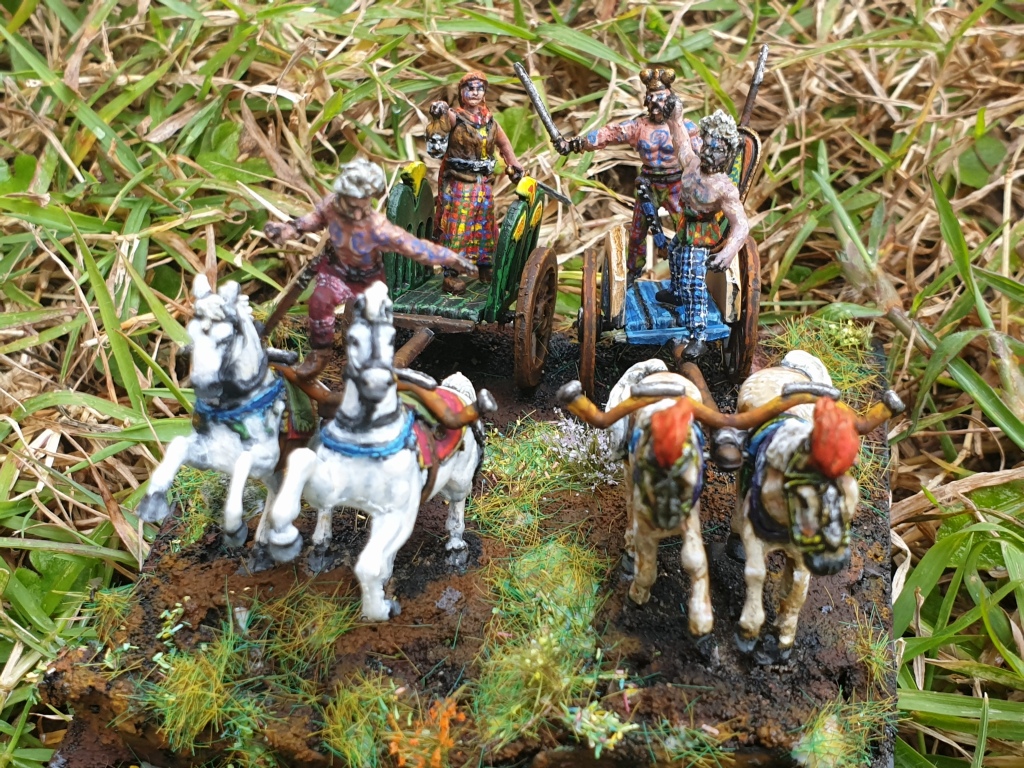
The Ardu Rota (Noble chariots – Ancient Brittonic) are the personal guard of Queen Aessicunia. It is they who guard the throne at all hours and they who take to the field by her side, atop their decorated chariots, when the tribe musters for war. Appointment to the guard is a matter of both prowess and politics; there are those who are given high positions in return for past favours and those who have throttled, punched and tore their way to the top.
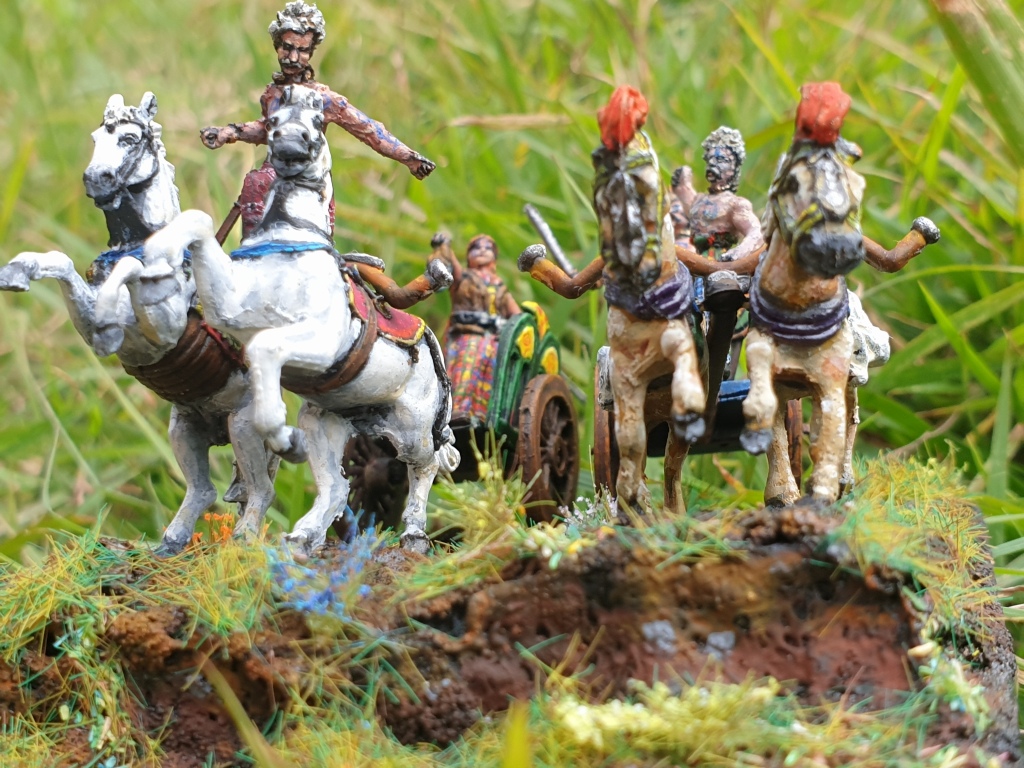
Aessicunia knows the power is a precarious perch and support must be sought across all corners, even from those she finds distasteful and even those she despises. Unlike her husband, she finds politics difficult. She assigns courtiers to advise, cajole and conceal, knowing what must be done because at her heart she is a bombast and a warrior, quick to anger, unmistakeable to all in the room.
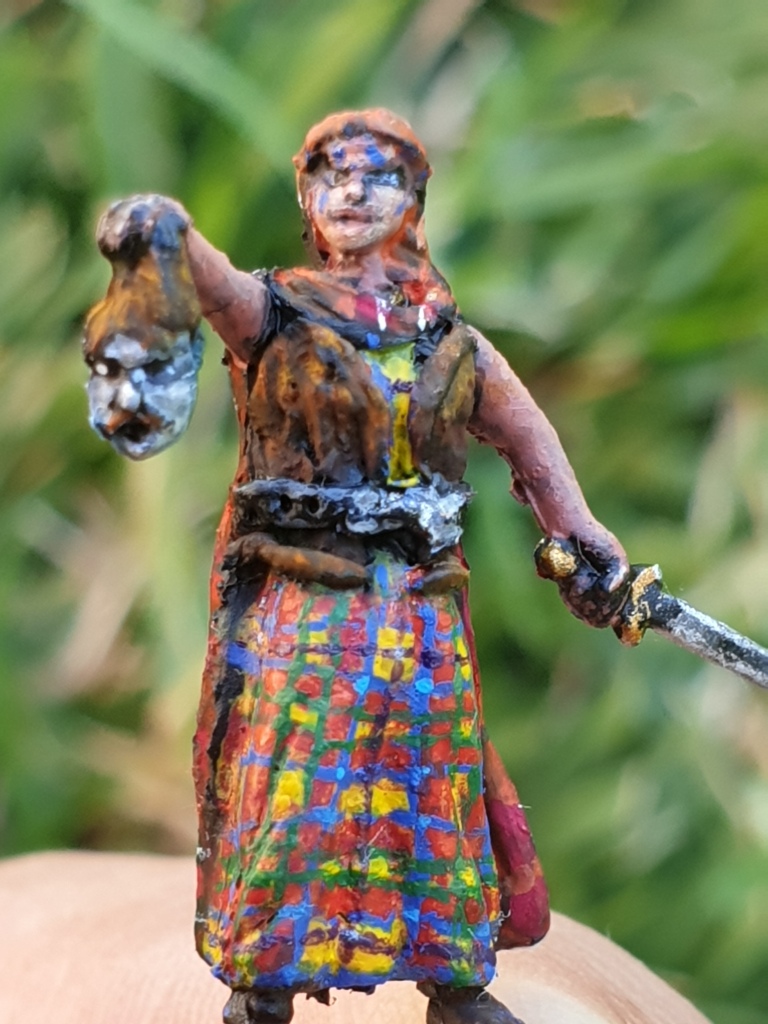
Her presence draws eyes from her proud steps, her upturned chin and her strong, masculine features which she bears without shame. Let lesser women cower behind the protection of men, singing pretty song and weaving their tresses, Aessicunia leads from the front, howling like a wolf, blade gleaming like quicksilver.

The battle leader of her guard is Breaninn, the Boar of Londinium. Breaninn is the strongest warrior of the tribe, with arms thick as barrels and a voice that rumbles like a bear’s. Clumsy and dim-witted, Breaninn could never be a leader, but this was never his wish and is happy simply to be in the thick of things. On her part, the Queen wishes fate had given her Breaninn to be her husband but she knows such fancies are for children and her duty is to her tribe and kinfolk. Breaninn, in typical Breaninn fashion, is content to fight, belch and drink. He thinks only as far as the next day and is completely unaware of the wishful eyes of his beloved Queen.

(As part of my effort to make each unit distinctive, the Ardu Rota is the grandest, largest, most colourful and most converted unit in the whole army. Each of the figures’ pants all took multiple days as I created the most difficult plaids and tartan patterns I could muster. The idea of this unit was simply to put patterns and colours in whenever possible, to different but always complex combinations. Each figure is also converted in a very time consuming process. The Queen is essentially my take on Boudica, who I’ve made a backstory for in my own games, and a figure I can use to represent Boudica in others. I green-stuffed a patterned leather vest to give her armour and to imitate her appearance from Total War Arena. My colour choice deviated – she had to be the most colourful figure in the army and have the most elaborate tartan as befitting the leader and therefore the thematic embodiment of the whole army. I gave her a rainbow tartan to ensure she captured as many other colours from the army as a whole as possible. Her chariot driver is modelled after the famous Osprey artwork, which required hours of greenstuffing an Italeri Celtic Warrior but I added rearing white horses because the pose felt so dynamic. These are from the Caesar Miniatures Saracen warriors kit.
This unit has horses of the same colour pulling each chariot to differentiate it from the Dewo-a Carbanto. Breaninn was inspired by the noble with outflung arms in the same Osprey artwork, but I made my own take on him by making him bare chested. He was originally a Revell Celtic warrior, with a modified pose. His woad of a triple swirl tree is matched by his driver’s single woad swirl. The idea of the woad swirl came from Rome Total War Two Iceni units. The driver is a blend of the standard Hat chariot driver and a Caesar Miniatures warrior torso. His pants are actually modelled after my own pyjama pants. This has been the most difficult yet satisfying unit to build and I’m proud to have this centrepiece!)
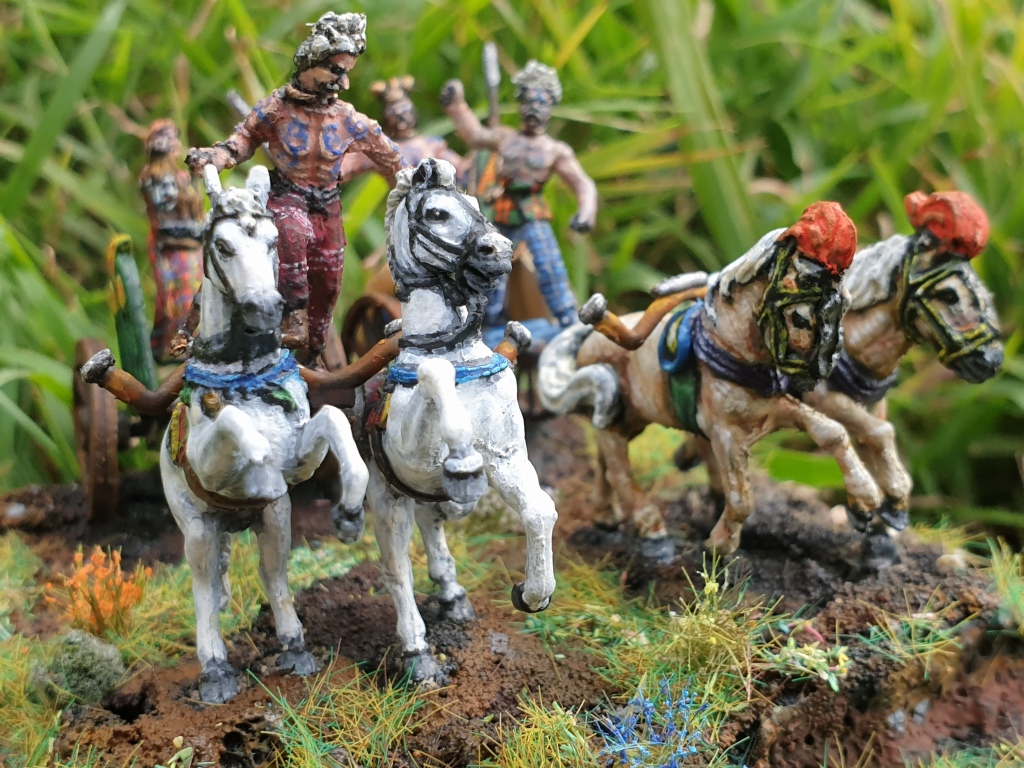
(Unit 6 of 11 - Ancient British army - Basic Impetus)
--
Also, because I won't get to my own version of the Roman legions for a few years at my rate of painting (planning Ancient Indians next), I reviewed the Zvezda Roman Legionary kit.
I have noticed that there's a different culture for historical wargaming and the Gamesworkshop community. One of my wargames club friends noted that historical wargaming videos tend to be just narration, no faces and many slides of depictions of battles. I think historical wargamers tend to be older as well and there's more of a focus on dioramas. I myself come from a tabletop gaming, Gamesworkshop background so I've always tried to find things which are more my flavour, more storytelling, "your-dudes" gaming and a few memes on the side.
Coming from a different angle, I've tried to make 1/72 videos as a form of entertainment, in the hope to expand the community to people who normally wouldn't be interested. It's a very different kind of video for 1/72 that I've seen, but at this point I'm just trying to scratch alternative itches and hopefully amuse some people on the way.
I have spent many weeks of research, converting and painting to do justice to this towering historical figure. (It's all downhill from here - no other Celtic unit is going to look as good as this one
“In stature she was very tall, in appearance most terrifying, in the glance of her eye most fierce, and her voice was harsh; a great mass of the tawniest hair fell to her hips; around her neck was a large golden necklace; and she wore a tunic of divers colours over which a thick mantle was fastened with a brooch. This was her invariable attire ...” wrote Dio, who also noted that she clutched a spear when she spoke to her people.
My incarnation of her fits with the theme of my Celts - a dash of colour, poised on her chariot, a head-taker and a warrior. I created my own version of the warrior queen archetype for use in my own games, but the model is, in spirit and substance; Queen Boudicca, freedom fighter, the one who dared to defy Roman rule.
--
1/72 Ancient British Celtic Army

The Ardu Rota (Noble chariots – Ancient Brittonic) are the personal guard of Queen Aessicunia. It is they who guard the throne at all hours and they who take to the field by her side, atop their decorated chariots, when the tribe musters for war. Appointment to the guard is a matter of both prowess and politics; there are those who are given high positions in return for past favours and those who have throttled, punched and tore their way to the top.

Aessicunia knows the power is a precarious perch and support must be sought across all corners, even from those she finds distasteful and even those she despises. Unlike her husband, she finds politics difficult. She assigns courtiers to advise, cajole and conceal, knowing what must be done because at her heart she is a bombast and a warrior, quick to anger, unmistakeable to all in the room.

Her presence draws eyes from her proud steps, her upturned chin and her strong, masculine features which she bears without shame. Let lesser women cower behind the protection of men, singing pretty song and weaving their tresses, Aessicunia leads from the front, howling like a wolf, blade gleaming like quicksilver.

The battle leader of her guard is Breaninn, the Boar of Londinium. Breaninn is the strongest warrior of the tribe, with arms thick as barrels and a voice that rumbles like a bear’s. Clumsy and dim-witted, Breaninn could never be a leader, but this was never his wish and is happy simply to be in the thick of things. On her part, the Queen wishes fate had given her Breaninn to be her husband but she knows such fancies are for children and her duty is to her tribe and kinfolk. Breaninn, in typical Breaninn fashion, is content to fight, belch and drink. He thinks only as far as the next day and is completely unaware of the wishful eyes of his beloved Queen.

(As part of my effort to make each unit distinctive, the Ardu Rota is the grandest, largest, most colourful and most converted unit in the whole army. Each of the figures’ pants all took multiple days as I created the most difficult plaids and tartan patterns I could muster. The idea of this unit was simply to put patterns and colours in whenever possible, to different but always complex combinations. Each figure is also converted in a very time consuming process. The Queen is essentially my take on Boudica, who I’ve made a backstory for in my own games, and a figure I can use to represent Boudica in others. I green-stuffed a patterned leather vest to give her armour and to imitate her appearance from Total War Arena. My colour choice deviated – she had to be the most colourful figure in the army and have the most elaborate tartan as befitting the leader and therefore the thematic embodiment of the whole army. I gave her a rainbow tartan to ensure she captured as many other colours from the army as a whole as possible. Her chariot driver is modelled after the famous Osprey artwork, which required hours of greenstuffing an Italeri Celtic Warrior but I added rearing white horses because the pose felt so dynamic. These are from the Caesar Miniatures Saracen warriors kit.
This unit has horses of the same colour pulling each chariot to differentiate it from the Dewo-a Carbanto. Breaninn was inspired by the noble with outflung arms in the same Osprey artwork, but I made my own take on him by making him bare chested. He was originally a Revell Celtic warrior, with a modified pose. His woad of a triple swirl tree is matched by his driver’s single woad swirl. The idea of the woad swirl came from Rome Total War Two Iceni units. The driver is a blend of the standard Hat chariot driver and a Caesar Miniatures warrior torso. His pants are actually modelled after my own pyjama pants. This has been the most difficult yet satisfying unit to build and I’m proud to have this centrepiece!)

(Unit 6 of 11 - Ancient British army - Basic Impetus)
--
Also, because I won't get to my own version of the Roman legions for a few years at my rate of painting (planning Ancient Indians next), I reviewed the Zvezda Roman Legionary kit.
I have noticed that there's a different culture for historical wargaming and the Gamesworkshop community. One of my wargames club friends noted that historical wargaming videos tend to be just narration, no faces and many slides of depictions of battles. I think historical wargamers tend to be older as well and there's more of a focus on dioramas. I myself come from a tabletop gaming, Gamesworkshop background so I've always tried to find things which are more my flavour, more storytelling, "your-dudes" gaming and a few memes on the side.
Coming from a different angle, I've tried to make 1/72 videos as a form of entertainment, in the hope to expand the community to people who normally wouldn't be interested. It's a very different kind of video for 1/72 that I've seen, but at this point I'm just trying to scratch alternative itches and hopefully amuse some people on the way.
-

CliosPaintingBench
- Posts: 828
- Member since:
14 Jan 2020, 06:46
-
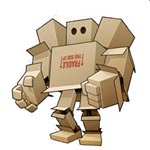
Kekso
 Moderator
Moderator Supporting Member (Bronze)
Supporting Member (Bronze) - Posts: 6883
- Member since:
19 Oct 2011, 18:32
Oh my! You are at my office! Well, I'm working from home right now so that's okay. ..... IF you leave some your nice figures and some of the terrain!
-

Susofrick
 Supporting Member (Gold)
Supporting Member (Gold) - Posts: 7713
- Member since:
19 Feb 2008, 12:10
Help keep the forum online!
or become a supporting member
Kekso wrote:Those patterns on clothing are
Thanks, they all literally took at least a week. I make a few mistakes when painting patterns at this scale and have to go back and correct them and the more complicated it gets the more I procrastinate and break it up into little bits every day.
morata92 wrote:Nice job, I would like to play a game with your figures and terrain. That must be a great experience.
Never say never, the logistics of transporting minis around is a nightmare but who knows, maybe once the world isn't in a global pandemic...
Susofrick wrote:Oh my! You are at my office! Well, I'm working from home right now so that's okay. ..... IF you leave some your nice figures and some of the terrain!
I'm a bit confused but you're talking to morata right? It seems more likely, my office doesn't have any Europeans branches I THINK, but I've been wrong on these kinds of things before.
-

CliosPaintingBench
- Posts: 828
- Member since:
14 Jan 2020, 06:46
I think I like having longer breaks in between units to have that mix of activities in real life, so updates may be more sporadic but around 2/3 of the army is done now and I fully intend on seeing this through to the end.
--
1/72 Ancient British Celtic Army
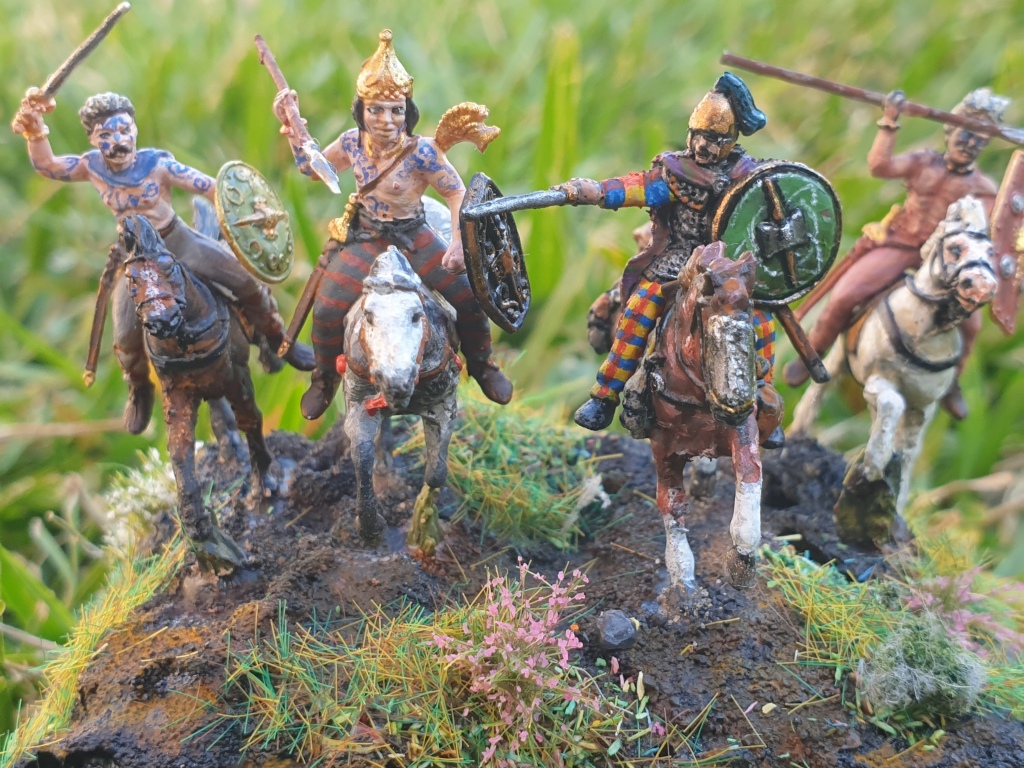
The Gabrantovicum (Horse-Riding Warriors – Roman British) have the prestige of horse-ownership - a sign of status and nobility within the isles. With this comes the freedom to move, to race, to fly, but in these dark times they must use their mobility to undertake the dangerous duties which other warriors cannot. They serve as messengers between the tribes and as the uprising grows, they scout enemy movements, galloping to vantage points to survey marching armies. Where the Romans are defenceless, they mount raids upon unprepared camps and lonely caravans, striking like lightning and leaving only laughter and bodies in their wake.
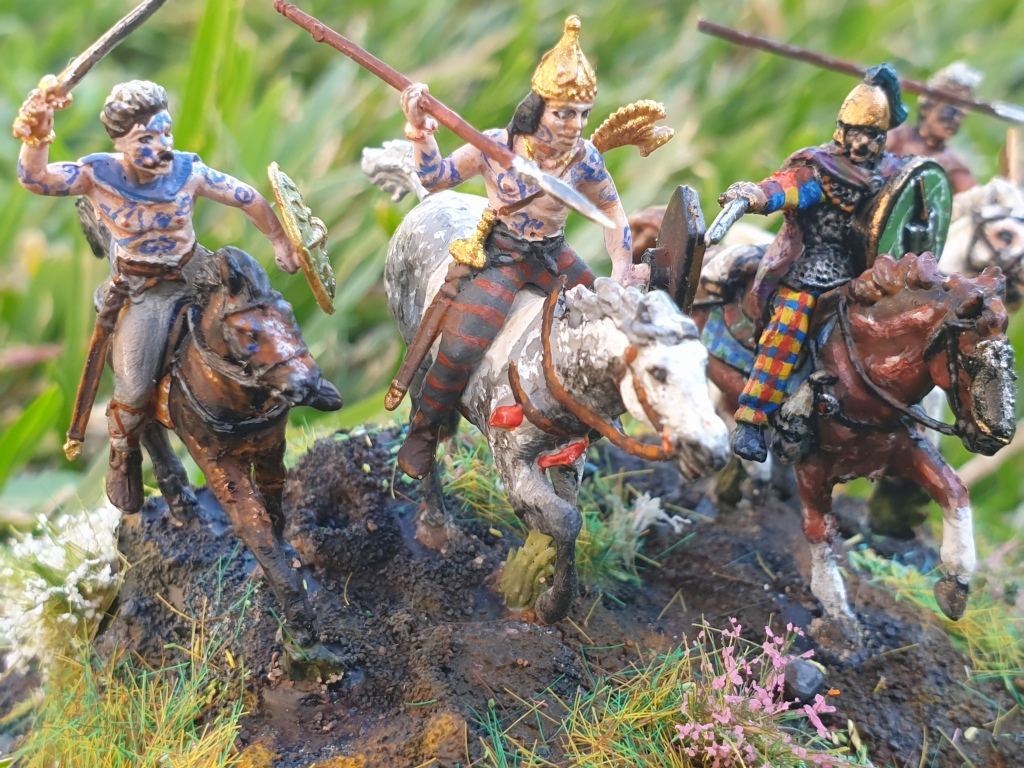
On the open field of battle, they are the most aggressive of the cavalry. They skirmish with enemy riders, striking and withdrawing before reappearing from unexpected quarters. They are gallant braggarts and attention seekers, seeking the heroic clash of single combat to make their names (and gain the attention of womenfolk) and they are the most reckless, headstrong and free-spirited of all the Iceni. Their numbers have been cut down from hurling themselves into the maelstrom but the glorious dead have earned their afterlife and the survivors know great fame is only won at great hazard. They are too light to fight ranked infantry head on, leave that for the bulk and momentum of the chariots, the pitiful laggards - but the gods help the Romans if they run, for there will be enough blood for all the thirsty gods of vengeance!
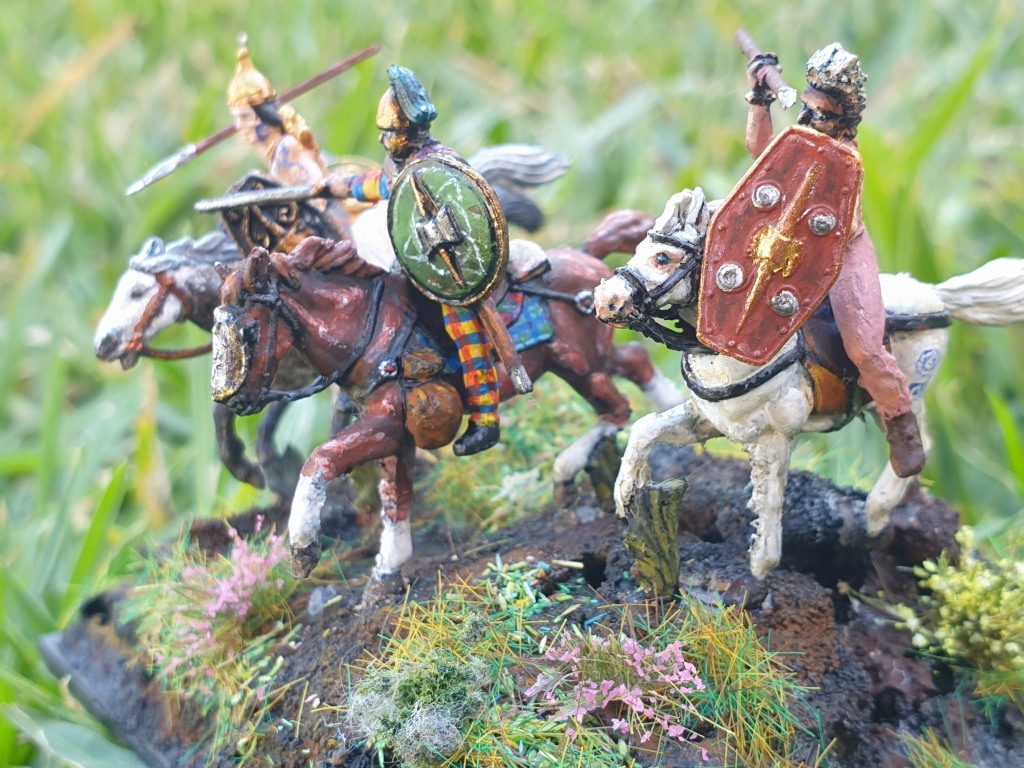
(As part of my effort to make each unit distinctive, the Gabrantovicum are my first light cavalry unit. I've posed them charging down a styrofoam hill and I wanted to evoke the idea of aggression and the cavalry rush. To contrast with this, my next cavalry unit will be sentries at rest. As horse-owning nobility, the Gabrantovicum's woad warpaint is very elaborate, full of swirls as opposed to the simple blue smears of the Bern-Acci or the future slinger or javelin units. To imply the idea of signalling, both cavalry units will have carnyces rather than standards; they travel light and fast. I wanted to do some woad warpaint on the horses themselves but I couldn't bear to alter the colours of the horses themselves, so the cremello pony has some swirls on its hind legs and the dark bay pony has curves over its eyes and I left it at that.
The bare chested warrior on the far right is a conversion of a Gallic Caesar Miniatures warrior's upper torso mounted upon an Italeri cavalryman's lower torso, with the sword arm replaced with a spear arm, then green stuff to fill all gaps. Every miniature in this army will be unique.
The leader of this unit has clothing directly inspired from our forum's very own Egbert: viewtopic.php?f=2&t=23602&p=258412
When I first saw the red, blue and yellow pants I was struck by how vivid the combination was. It's not how I usually do plaid, but I like little tributes to the models that inspire me. This one's for you sir!
I thought if any cavalry units should have ponies, it should be my ancient Britons, the disorganised ragtag ruffians. In part, I was also inspired by this line from Steven Pressfield's Alexander The Virtues of War, one of my favourite books: "These savages stand a head taller than we do, massive specimens who can lift their own ponies..." (Page 116) So ponies, they have.
it is quite difficult to research the unit names for the Ancient Britons... I've resorted to using a Roman British name because I'm running out of words to make names with.)
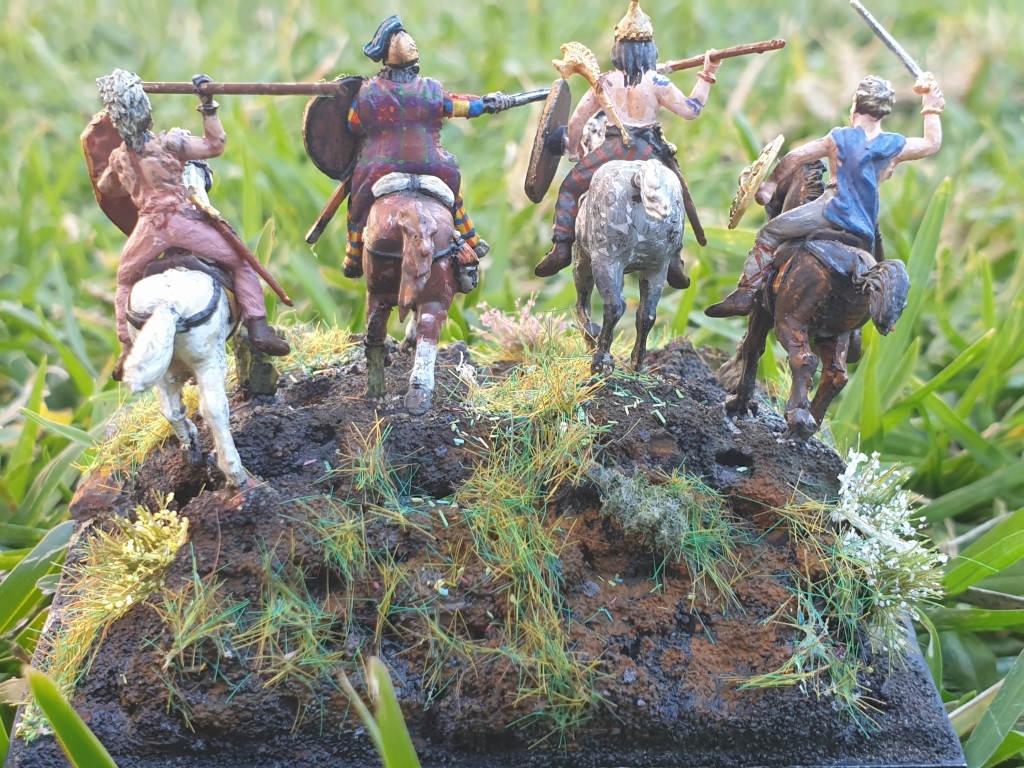
(Unit 7 of 11 "the go-to place for all your convenience store needs" - Ancient British army - Basic Impetus)
--
1/72 Ancient British Celtic Army

The Gabrantovicum (Horse-Riding Warriors – Roman British) have the prestige of horse-ownership - a sign of status and nobility within the isles. With this comes the freedom to move, to race, to fly, but in these dark times they must use their mobility to undertake the dangerous duties which other warriors cannot. They serve as messengers between the tribes and as the uprising grows, they scout enemy movements, galloping to vantage points to survey marching armies. Where the Romans are defenceless, they mount raids upon unprepared camps and lonely caravans, striking like lightning and leaving only laughter and bodies in their wake.

On the open field of battle, they are the most aggressive of the cavalry. They skirmish with enemy riders, striking and withdrawing before reappearing from unexpected quarters. They are gallant braggarts and attention seekers, seeking the heroic clash of single combat to make their names (and gain the attention of womenfolk) and they are the most reckless, headstrong and free-spirited of all the Iceni. Their numbers have been cut down from hurling themselves into the maelstrom but the glorious dead have earned their afterlife and the survivors know great fame is only won at great hazard. They are too light to fight ranked infantry head on, leave that for the bulk and momentum of the chariots, the pitiful laggards - but the gods help the Romans if they run, for there will be enough blood for all the thirsty gods of vengeance!

(As part of my effort to make each unit distinctive, the Gabrantovicum are my first light cavalry unit. I've posed them charging down a styrofoam hill and I wanted to evoke the idea of aggression and the cavalry rush. To contrast with this, my next cavalry unit will be sentries at rest. As horse-owning nobility, the Gabrantovicum's woad warpaint is very elaborate, full of swirls as opposed to the simple blue smears of the Bern-Acci or the future slinger or javelin units. To imply the idea of signalling, both cavalry units will have carnyces rather than standards; they travel light and fast. I wanted to do some woad warpaint on the horses themselves but I couldn't bear to alter the colours of the horses themselves, so the cremello pony has some swirls on its hind legs and the dark bay pony has curves over its eyes and I left it at that.
The bare chested warrior on the far right is a conversion of a Gallic Caesar Miniatures warrior's upper torso mounted upon an Italeri cavalryman's lower torso, with the sword arm replaced with a spear arm, then green stuff to fill all gaps. Every miniature in this army will be unique.
The leader of this unit has clothing directly inspired from our forum's very own Egbert: viewtopic.php?f=2&t=23602&p=258412
When I first saw the red, blue and yellow pants I was struck by how vivid the combination was. It's not how I usually do plaid, but I like little tributes to the models that inspire me. This one's for you sir!
I thought if any cavalry units should have ponies, it should be my ancient Britons, the disorganised ragtag ruffians. In part, I was also inspired by this line from Steven Pressfield's Alexander The Virtues of War, one of my favourite books: "These savages stand a head taller than we do, massive specimens who can lift their own ponies..." (Page 116) So ponies, they have.
it is quite difficult to research the unit names for the Ancient Britons... I've resorted to using a Roman British name because I'm running out of words to make names with.)

(Unit 7 of 11 "the go-to place for all your convenience store needs" - Ancient British army - Basic Impetus)
-

CliosPaintingBench
- Posts: 828
- Member since:
14 Jan 2020, 06:46
Ochoin wrote:Owen: wonderful stuff!
BTW if figure paining ever grows old for you, have you considered a career as a tattooist?
donald
Haha they do look a bit tatted up don't they?
Hope we get a game in at some point, when covid lockdown ends, looks like it's rising again but when borders reopen maybe the celts can fly too
-

CliosPaintingBench
- Posts: 828
- Member since:
14 Jan 2020, 06:46
OwenChpw wrote:
Hope we get a game in at some point, when covid lockdown ends, looks like it's rising again but when borders reopen maybe the celts can fly too
I have a Celtic army (not nearly as nice looking as your one) too.
They have, to date, NEVER beaten my pal's Polybian Romans. Not once. Never.

What might be nice would be a tribal clash of Celt versus Celt. At least that way, one Celt army would win.....
donald
-

Ochoin
- Posts: 2491
- Member since:
16 Jan 2010, 04:00
Ochoin wrote:What might be nice would be a tribal clash of Celt versus Celt. At least that way, one Celt army would win.....
Haha, it's looking like it won't happen soon, but I would like the Celts to triumph (even over other Celts) They're such characterful models on the tabletop, they've got personality!
Peter wrote:Like them a lot Owen! Can't wait to see the next ones!
Mate, it took a period of three weeks to get these done from start to finish (with life, movie, novel and work breaks of course) and it just began to wear at my patience. It's the plaids, the highlights on the horses, the eyes that take so much concentration that it just drains my motivation over a while. I'm very glad to have completed them, but I want to do them when I'm enthusiastic about them, otherwise what's the point of the hobby? I'm going to take a sanity break after making another Youtube tutorial, read some old novels (The Iliad, As I Lay Dying, Liar's Poker) before coming back with a fresh mindset. Army's nearly done, when the battle's lost and won. Just three more units of skirmishes left, it's almost a pity.
--
1/72 Ancient British Celtic Army
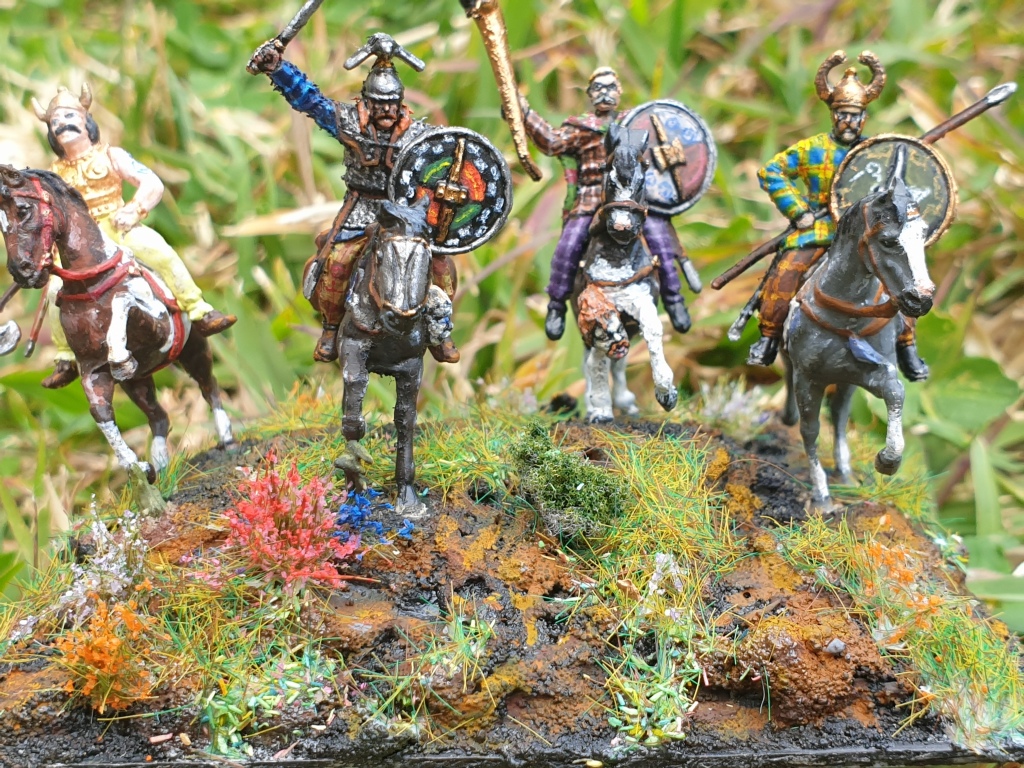
The Agrā-Epona (Hunt of Epona – Ancient Brittonic) are the quiet watchers of the Iceni, the patrollers of the borders, the far roamers. They have travelled further than their kin, having disappeared for months on end only to reappear battered and wild-eyed, brandishing scars, loot and loud tales of strange peoples and derring-do.
Their warleader Caratacos is no larger or stronger than any other Celt. What marked him apart was his mind; his capacity to intuitively grasp problems and solve them, to know the hearts of men. Caratacos harbours a secret admiration of Roman society and its systems of administration, envisioning a future where both their peoples are at peace and where they may learn from each other.
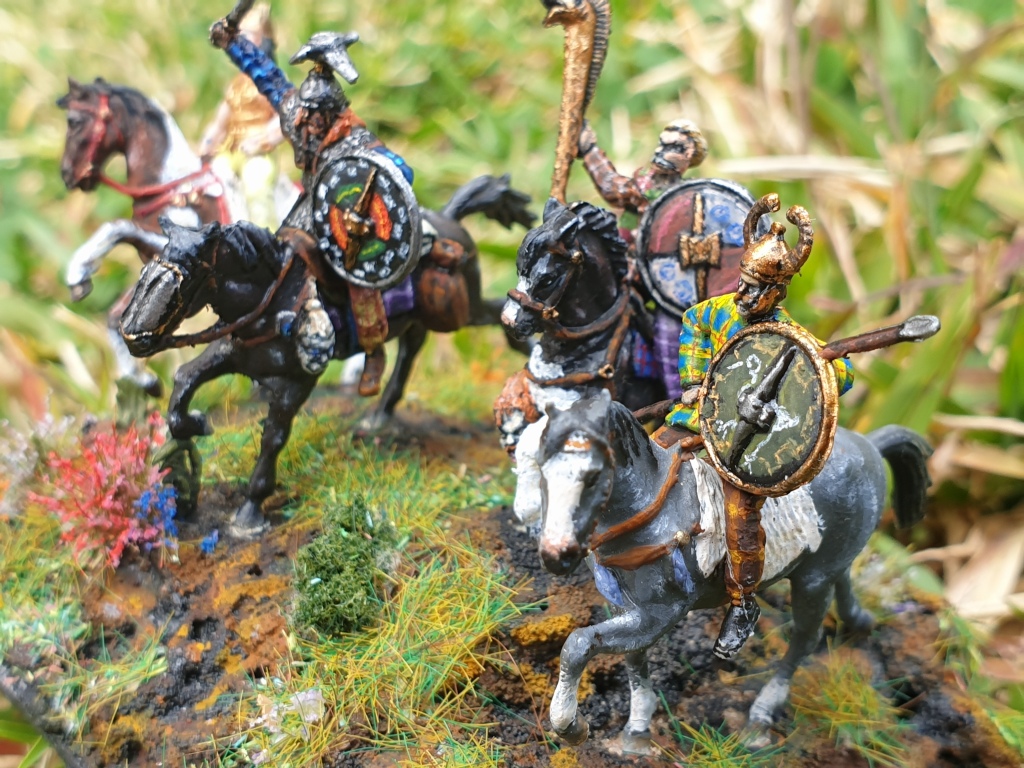
In this time of war, Caratacos has instructed his men to hold, to be patient and use their speed and prowess where it is most applicable. Some may denounce his methods as cowardly, as the Ancient Britons fight in the time-honoured manner: in single heroic combats and bold, courageous challenges. But Caratacos sees a time when war will not be as such and winning will come before glory. He bides his time, and the Agrā-Epona's strength for when they will be needed.
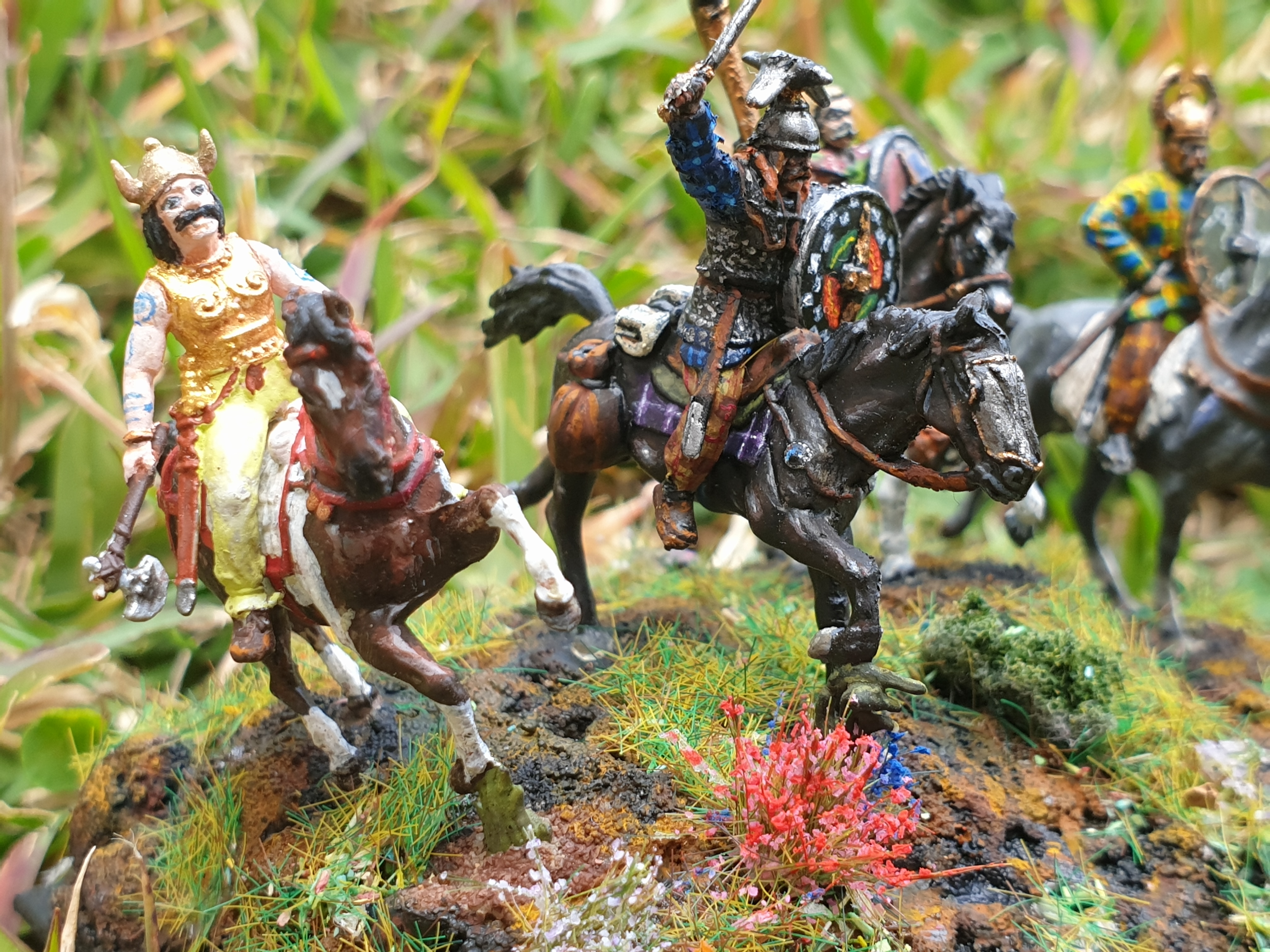
The Agrā-Epona are worshippers of Epona, the protector of horses, ponies, donkeys, and mules. They offer sacrifices in the wake of victories, taking the heads of their enemies to bind their souls to Epona. While the Gabrantovicum charge ahead for glory, the disciples of the horse goddess lurk and prowl on the borders, waiting for a good opening, but they bear no resentments for their honour-seeking brothers. Caratacos has gathered men of his ilk under him, men of practicality and reason who seek something far more precious than glory - victory.
(As part of my effort to make each unit distinctive, the Agrā-Epona are my second light cavalry unit and had to be differentiated from the first. They survey the battlefield atop the styrofoam hill, while their warleader Caratacos begins the charge that will carry them downhill. With this unit, I wanted to contrast with the Gabrantovicum by making the Agrā-Epona at ease. They are the patient hunters, not the reckless glory-hounds. I wanted this unit to emphasise the plaid and tartan aspect of Celtic Briton, so the shirts and pants are mostly elaborate patterns. I was looking for inspiration and I found some Newline Designs miniatures which I thought looked fantastic: https://www.pinterest.com.au/pin/623044929692118446/ which I tried to replicate on my leader and the figure most to the right.
They still have a figure with woad on the most left, but I wanted the Gabrantovicum to be defined as the woad-painted cavalry unit in this army. As they are both light cavalry, both units have carnyces rather than standards, to signal. This unit's shields are all circular, to contrast again. I tried a border check pattern and a ridged pattern, both which I've seen on Celtic shield transfers. This throws in some visual variety but still ties into the overall image of the Iceni army.
Regarding the horses, we have no woad warpaint on these mounts; I love the bare coats of the horses too much. I decided I had to emphasise the idea of Celtic head-taking, and so the musician's horse is a HaT late Roman horse with a Celtic head greenstuffed onto the front. The horses are also as many different colours as possible to keep in theme with the Celt's multi-colour look and to just add more variety. We have Skewbalds, Piebalds, a brown tinged black and a grey.
The name Agrā-Epona - is Hunt and Epona tacked together - I can't work out the ancient Brittonic possessive grammar form or what the word for 'of' was, so this will have to do. I came here to paint miniatures, not get an ancient languages degree.)

(Unit 8 of 11 - Ancient British army - Basic Impetus)
-

CliosPaintingBench
- Posts: 828
- Member since:
14 Jan 2020, 06:46
Thanks fellas! The shields can get a bit tricky, but I think they stand out on the tabletop.
-

CliosPaintingBench
- Posts: 828
- Member since:
14 Jan 2020, 06:46
Help keep the forum online!
or become a supporting member
Wow, OwenChpw, you have a huge and very well painted Celtic army, with a great mix of figures from different manufacturers. 
They are a pleasure for the sight.
Santi.

They are a pleasure for the sight.

Santi.
-

Santi Pérez
- Posts: 2089
- Member since:
28 Aug 2016, 19:42
To paint and present figures along with communication skills,
can become an awfully big adventure. Well Done. BB
can become an awfully big adventure. Well Done. BB
-
Beano Boy

 Supporting Member (Gold)
Supporting Member (Gold) - Posts: 8125
- Member since:
03 Sep 2013, 14:45
What a beautiful army!! The basing for the cavalry was outstanding!!! Really original as heck I love it.
-
PaulRPetri

- Posts: 675
- Member since:
02 Apr 2019, 00:59
83 posts
• Page 2 of 5 • 1, 2, 3, 4, 5



